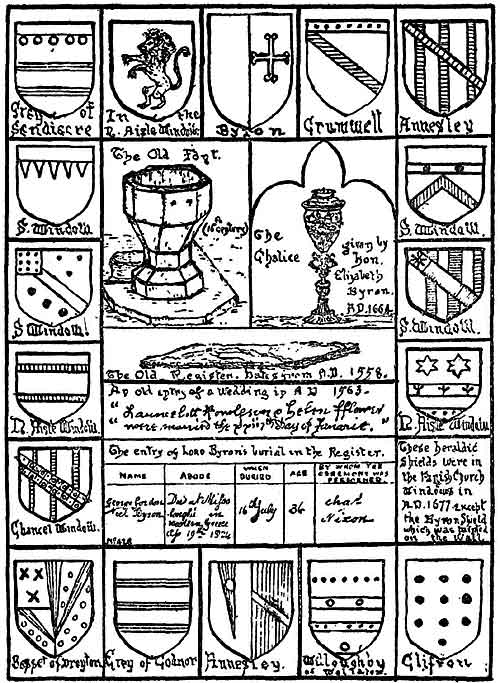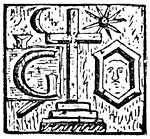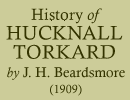< Previous | Contents | Next >
The late Duke of Portland gave to the church a casket made of Sherwood oak, beautifully carved, and in it for twenty years some of the church plate was stored. The casket is kept in the chancel.
Viewed architecturally the church exterior does not impress the spectator as a well-proportioned building. The congeries of roofs which cluster beneath the tower dwarf the latter and suggest the need of a spire. A widely different impression is made on the visitor who enters the porch door, for a fine vista, of Gothic arches meets the gaze, and when the eye gets accustomed to the subdued light he sees objects of beauty all around.
Twenty-seven of the stained glass windows are the work of Kempe, who has done much to restore this branch of British art to its medieval excellence. His faces, feathers, and jewelled embroidery are particularly fine in the Hucknall windows. It is difficult to say which is the most beautiful window in the church, but many will probably agree with " Pilgrim," a travelling correspondent for a London paper, who awards the palm to the three-light chancel window, whereon are portrayed the figures of the Virgin, Mary Magdalene, St. Elizabeth, and her boy John the Baptist. Much admiration has been excited by the Incarnation window in the north transept, where the special points are the Virgin's face, the announcement to and departure of the shepherds to Bethlehem, and the stable barge-board, a copy of that in the church porch. The various studies in the Atonement window in the south transept are equally beautiful.
In the large east window, one of the disciples at Emmaus is supposed to resemble Byron. The baptistry window portrays Christ as the Redeemer of Children, and is a copy of one Mr. Kempe produced for the Princess Alice in memory of her child, who fell from the Castle balcony in Hesse Darmstadt.
Almost all the windows were given by the late Canon Godber, and the parishioners, in recognition of his benefactions to their church themselves placed a window in the south aisle as an expression of their gratitude to him. The Canon chose the subject of the window, which depicts a scene on the shore of Galilee on the occasion when Christ commissioned Peter to "Feed My Lambs," the reference pertaining to the Canon's pastoral office.
The parishioners commemorated in stained glass in the church are:— John Godber, sometime resident at Whyburn House (father of the Canon), and Henry Hankin and Edward (his sons); also Ann Needham, Elizabeth, Eliza, Sarah, and Ann Godber. The late William Needham Ball, of Beacon Hill, and his sister, A. Needham Ball, James Widdowson, churchwarden, and George and Rachel Stevenson, of West Street Farmhouse, are also commemorated by windows.
In Dr. Thoroton's time, the church windows were embellished with stained glass shields, bearing the arms of notable families who held land in the parish at different periods. The Vicar fortunately has in his keeping a portion of one of the shields. The accompanying engraving shows some of them copied from the Torre MSS in York Cathedral Library.
The decorations on the walls are exceptionally profuse, and consist mainly of mosaics, diaper-work, and paintings on linoleum. There are three mosaics, two are on the north aisle wall, and illustrate the home-coming of the Prodigal Son, and "Praise." The other is placed over the porch entrance.
The linoleum paintings of saints and angels are situated in the chancel and transepts, and the largest occupies the whole breadth of the tower wall above the arch, and represents Christ seated in glory. These embellishments, together with the diaper-work on the chancel wall and west end of the nave were all executed at the cost of Canon Godber.
 |
FONT.
The font is a heavy, rude, hexagonal piece of 14th or 15th century work, and bears traces of having at tome period been surmounted by a wooden cover in compliance with an edict to prevent misuse by intruders, especially the superstitious use of the water for curative purposes.
 |
THE BELLS.
Bishop Latimer, in a sermon, said: "If all the bells in England were rung at one time, I think there would be almost no place where bells could not be heard.''
There are three bells in the tower. The treble is the oldest, and bears the inscription "Ave Maria" (Hail! Mary!). A bell expert gives the opinion that this was originally used at some Abbey. As the belfry was built in 1320, at a time when the Prior of Newstead was patron of the living, it is likely the bell came from Newstead. When the Abbey was dissolved by Henry VIII. it possessed four bells.
The second, or tenor bell, bears date 1639, the year following that in which the Byrons began to use the church as a family burying-place. It carries the inscription "God save the Church," a very pertinent prayer at that stormy period of church history. The bell is elaborately decorated, in good condition, and was cast at George Oldfield's foundry, at the back of Long Row, Nottingham, at a time when many bells were being made there, judging from the number of Oldfield's bells hanging in Nottingham, churches. His monogram is given at the head of this chapter.
The third, or bass bell, was cast in 1749 by Thomas Hedderley at Nottingham, and bears the name of "Theophilus Allcock, churchwarden." This Mr. Allcock was landlord of the Red Lion Inn later in the 18th century, perhaps the chief hostelry in the parish in those days, for the Byron tenantry were feasted there on their annual rent days; Mr. Daws, Lord Byron's steward, was a Hucknall resident.
An attempt was made in 1905 to increase the number of bells, but the death of Canon Godber and other circumstances caused the effort to flag.
Before leaving the subject of the bells the interesting old custom of ringing the Pancake Bell at one o'clock on Shrove Tuesdays must be mentioned. John Brown, parish clerk and sexton, during the vicariates of George Otter and John Edward Phillips, rang the bell regularly. The custom was probably a relic of olden days, when the "shriving" gave the day its name.
